The Placement of Different Figures Ap Art History
AP Fine art History
Advanced Placement examination, organized by the College Lath is one of the important teaching programmes in USA and Canada. It offers college-level examinations to senior loftier school students. This exam provides the students with the take chances to earn college credit, advanced placement. It's governed the College Board and a committee of selected teachers and other intellectual personae. The Assignment of the exam is vast and interesting and various, from Art history to biological science, which makes information technology pretty tough equally well every bit interesting. Here we'll talk about Fine art History.
The Art History exam allows the students to study and analyse important forms of artistic expression which are relevant to various cultures from dissimilar time period. The Assignment gives the students an opportunity to acquire the power to examine and analyse the work of fine art critically. The main topic in this Assignment is European art along with the African, Hindu, South and East-Asian art.
Let'southward take a expect at the Assignment structure. It tin be roughly divided into iii parts:
- Ancient to Medieval
- Renaissance to Present
- Across European Trend
The test is divided into 2 sections: multiple choice and costless response, each having 2 sub parts. The MCQ office includes 115 questions with a time period of lx minutes. The Free Response part includes ii 30 minutes essay question and six 10 minutes questions. The 10 minutes questions are based on work of art or quotation from a source or a document. Students must support their answers with an example of apt piece of work of fine art.

The students must know these basic things for the exam
- Power to utilise basic learning about fine art and its history
- Knowledge about different types of art, different types of art work from unlike periods
- Ability to analyse the piece of work of art
The Assignment includes:
- 40-l% Assignment on painting and drawing
- 25% on architecture and design
- 25% on unlike forms of sculpture
- 5-x%on other media such as photography, ceramics etcetera.
Ancient to Middle:
Ancient Art:
This part can be sub divided roughly into 3 periods:
- Paleolithic or Old Stone or c40,000-eight,000 BCE
- Mesolithic or Center Stone Age, c8,000-7,000 BCE
- Neolithic or New Stone Historic period, c7,000-two,300 BCE
Paleolithic fine art:
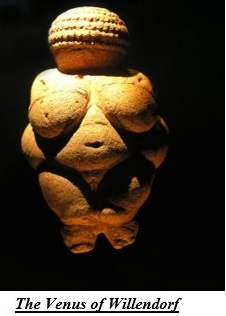
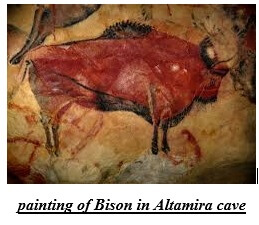
During this fourth dimension art was of 2 kinds, either 'portable' or 'stationary'. Portable fine art was used to be modest in size, mostly either figures or objects, carved from stone, bone or modelled with clay. The figures of pregnant females are often referred to as the ' Venus'.
'Stationary' art refers to the immovable fine art examples like the cavern paintings in Europe. The painters derived the paints from minerals, charcoal, ochre mixed into mediums like blood, water, fauna fats. These Paintings may have some other symbolic importance. The paintings of the animals are quite realistic.
Some of the key characteristics of this age art are:
- The art objects were associated with daily lives and the usual work like food hunting, fertility rights and so on.
- Some of the images surprisingly generates possibility of abstract thinking
Mesolithic Period:
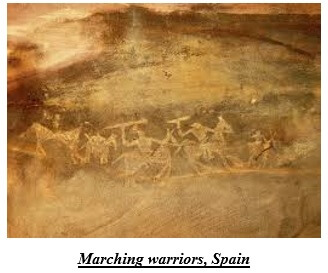
This menses was a transitional one, with the change in atmosphere, geography and so on. The stick like and abstract human figures had been replaced past images of human being beings in groups, like the 'Marching Warriors' in Castellon, Spain.
Neolithic Period:
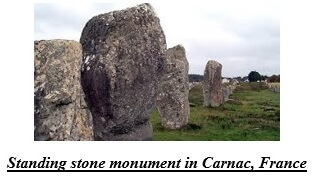
This period saw a distinct change from painting images to building sculptures, monuments and architectures with huge stones, like the 'Standing Stone' monument in Carnac, France or the ' Stonehenge' in England.
Art of the Ancient East:
Aboriginal East more often than not refers to the expanse around Turkey, Iran, Iraq. The development of art in this area is roughly divided into four phases.
Neolithic Communities:
This seems to exist the world's oldest fortified community which enabled them to start making monumental architecture like the ' Jericho', 'Seated Goddess'.

Sumerian Fine art:
Around 3500 BCE, the city states began to grow forth the river
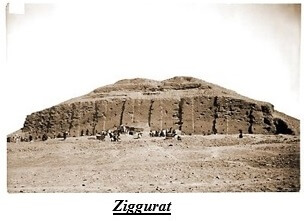
Mesopotamia. This city country of Sumer is considered to be one of the greatest civilizations. ' Ziggurat' is their famous architecture which was supposed to be a religious shrine, symbolizing the connection between men and god and earth.
Gradually the Akkadian, Babylonian, Assyrian art flourished through-out the ages.
Ancient Egyptian Art
During the kingship of Menes, upper and lower Egypt was united as kingdom

and and then began the dominance of pharaoh. As we can see in the architecture besides, one of the virtually important architectural figures was Imhotep, the chancellor and court builder. Along with this, during the early Dynastic period, funerary rites also became an important part of the civilization which resulted in production of ' Mastabas', apartment topped, one story edifice, erected over underground burial chambers. During dynasty Iii, IV, those were replaced by 'pyramids'.
They used Relief sculpture and painting to decorate interior of tombs, living quarters for deceased's ' ka'.
During the middle kingdom, the size of the architecture became much smaller due to financial trouble and social instability.

Deserted temple of Hatshepsut
During dynasty 18, with the restoring of peace and stability, architectural prosperity once more started to flourish, around the city of Thebes. During the reign of Amenhotep Iv, the say-so of sun god Aten came into being. Amenhotep inverse his name to Aten. Temple in larger shape began to emerge, like temple of Ramesses Two, Nefertiti and and so on.
Ancient Greek art:
The style of Greek fine art focuses on humanism. The Dorians and the Ionians were the earliest people to create groups based upon language and other common beliefs. This civilization is divided between several periods.
Geometric period:
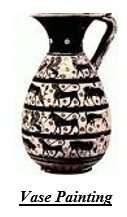
Vase painting was a pretty important norm during the Geometric period. The decoration consists of abstruse designs surrounding the Vase which was supposed to be designed for votive prayers.
Orientalizing menstruum:
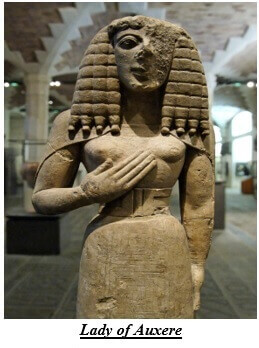
During this period, the decorating patterns became larger and the figures of the living beings became more lifelike. If we come across this statue of ' Lady of Auxerre' nosotros can see that the abstract figures had been replaced by more than concrete fleshy figures, equally an influence of Asia Small-scale.
Archaic period:

During this catamenia, artefacts were made by rock, marble. The Doric influence could be seen in the fluted columns of the Temple of Hera, Temple of Korkyra. The statues were life like, embedded with an expression known as ' archaic grin'. The female figures are known ' kore', the male as ' kouros'. Athens produced near of the vase paintings along with Black figure and Red figure technique.
Early Classical Menstruum:

During this time the columns of the temples became more spacious, the vertical shaft had been transformed into horizontal one, due to the result of Persian invasion. Unlike the aboriginal Egyptian flow the human being figures now, had become more lifelike, acquiring an almost 3D effect.
High Classical Period:

The most important structure of this time was Parthenon in 438 BCE nether
the management of Pheidias. Other examples are ' three seated goddess', 'Horsemen' etcetera. During this time the sculptors were used to believe the beauty could be constitute into true form only equally we tin encounter in ' Nike adjusting her sandal', 'Myron Diskobolos' and so on. Later the way got inverse due to the tyranny of Kritias.
Aboriginal Roman art:
Ancient Republican art was very much influenced by the Greek art, specially that of Magna Graecia, the Greek colonies of the Southern Italy. 1 of the most prominent influences is the creation of mosaic on floors. Each piece or ' tessarae' of the mosaic was supposed to be limestone or marble and flat. The hard 1 is the wall mosaics. The labourer or the ' musearii' was more paid than the others. They used coloured stones besides. Like the use of mosaics, the Greeks inspired the Romans in pottery too. The Romans began to brand the Cherry effigy vases roughly during 450 B.C. which gradually flourished in 14th century in several places like Apulia, Campania, Sicily and others. During the 2nd century B.C., with the Greek migration the Romans started to use Bronze as new ingredient to furnish artefacts. The Romans were influenced past the Greeks in the area of sculptures too. Earlier they used wooden models for marble sculptures. They worshipped their ancestors which fabricated them to use their images on money. The Greek realism affected the Romans too which resulted in making life sized statue. During the afterward Roman flow, the newly arrived Christian tradition got mixed with the pre-existing Infidel tradition and developed a mixed form. Amid these, the paintings were also very important. Paintings similar 'Simulated Rites of The Cult of Bacchus' in the Villa of the Mysteries, ' Woman with a veil' are important. Amidst the sculptures of Roman empire, the most famous one is the ' Colosseum', 'The Arch of the Titus', 'The colossal statue of Constantine' and and so on.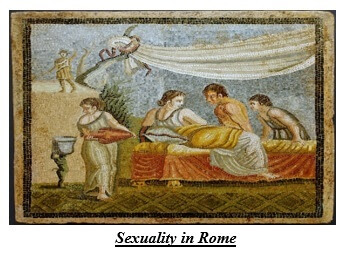
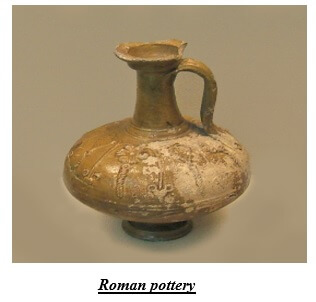

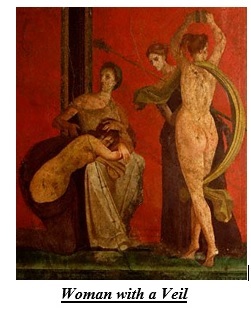

Early on Christian, Jewish, Byzantium Art:
During 325 A.D., Christianity became the official and the sole religion with the sanction of Emperor Theodosius I. Rome became divided both politically and religiously with Constantinople existence the capital.
The earliest examples of wall paintings tin exist found within the catacombs, carrying mutual religious letters. Due to the sanction of Constantine, several churches, basilicas started to be built.
The virtually important structure of Byzantine era is the construction of Hagia Sophia. Apart from this, at that place were works on mosaics, iconography and manuscripts and so on.
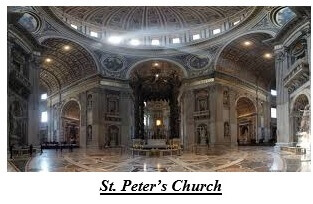
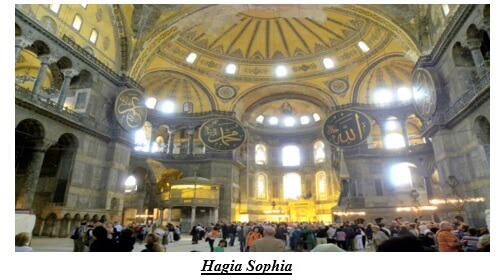
AP Art History Medieval to Renaissance
Avant-garde Placement Art History examination is one of the of import and interesting Assignments. The Assignment is roughly divided into sub parts. Here we'll talk nearly the transition in the work of art from Medieval to the Renaissance period.
Medieval period:
The Medieval fine art period is a vast one and therefore is roughly divided into many sub-periods like Early on Christian art, Byzantine art, Romanesque period and of Assignment the Gothic menses. Every period has some distinct style of its ain. Here nosotros'll mostly focus on the Romanesque and Gothic flow.
Romanesque art:
This style is an adaptation of Roman way and manner of building solid structures similar masonry walls, rounded arches and and then on. There seems to be an first-class sense of uniqueness in various types of works of art, from architecture, wall painting to painting of tapestry. This uniqueness seems to exist the product of the beautiful symmetry amongst the workers with unlike focus on different types of styles.
In the area of architecture the basic characteristic is the plan of the basilica with the variations of masonry vaults and buttress, the introduction of Ambulatory.
'Ambulatory' is a semi-round or polygonal side in the structure, every bit we can see in the epitome of Notre Matriarch. The famous examples of this kind of style are the Abbey church building of Sainte-Foy, France, Church of Notre Matriarch, France etcetera.
Another significant feature of the Romanesque art is the style of Carved Portal . Initially the images describe the Biblical stories, folklores, stories on
Christian symbolism, later; those got replaced by scenes glorifying the Christ and the 'Last Sentence'. Apart from the Carved Portal style, from this time onwards, the mosaics on the church wall began to be replaced past the wall
paintings. In England, the British people started to use stone for vaulting and to build walls around the church in an experimental manner.
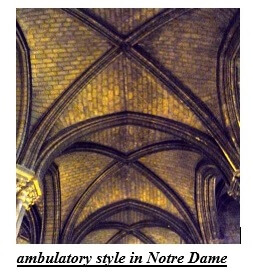
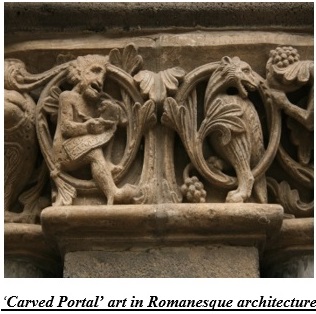


Gothic Art:
Gothic art originated from in French republic in 1137 from rebuilding of the Abbey
Church of St. Denis. The word ' Gothic' refers to ' barbarian. Its became popularised by painter Georgio Vasari who addressed it as " monstrous and fell'. This includes the sculptures, portals, other figures which are an integral part of that style. During the thirteenth century it became the nearly got replaced by the Gothic buildings which include larger windows, stained glass. Some of the other significant features of Gothic Art are the utilise of frescos, illuminated manuscripts, console painting. It mainly focuses on the figures and characters of the 'Erstwhile Testament' and sometimes those forth with the ones from New Testament and the images based on the ' Virgin and the Child' were placed side by side as in the 'Speculum Humane Salvations'.
During the early 14thursday century another style of Gothic art emerged, known as the International Gothic Art' every bit we tin see in the Tres Riches Heures du Duc de Drupe.

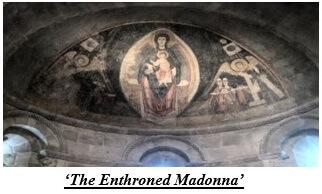
Renaissance Art:
The time flow betwixt 1400 and 600, the world witnessed a ' revival', renewed interest in classical learning and humanism. This menses is known as ' Renaissance' meaning ' rebirth'. Along with these new interests this period also saw the great outcome of discovering and exploring new land. Unlike the Medieval time, during the Renaissance the artists were being recognized by their works. Due to the progress of science many new techniques began to evolve. The artists started to develop a perspective. A new idea came into being to brand the figures more than proportionate, more lifelike.
Renaissance in Italy:
Amidst the pioneers of Renaissance in Italy 3 most important Florentine personae are Filippo Bruenleschi, Lorenzo Ghiberti and Donatello. Brunelschi developed the concept of Linear Perspective. Brunleschi revived
the classical use of cavalcade. He used it in his pattern of Octagonal dome of Florence Cathedral or Duomo. He was responsible for bringing into foreground an infrequent use of spatial integrity, unique during the contemporary time. Ghiberti is renowned for the famous sets of doors illustrating the themes from Former Testament which had been praised past Michelangelo as the ' Gates of Paradise'. Donatello was the most famous amidst all of them. His best known work is the Bronze statue of David the Biblical hero, with the head of Goliath at his feet. Among the following artists, the important ones are Masaccio, Bellini, Mantegna and and so on. Masaccio used both linear and aerial perspectives in his frescoes depicting the life of St. Peter for Branacci chapel in Florence's Santa Maria del Carmine. In ' Tribute Coin' he portrayed the figures with utmost reality. Apart from Masaccio, Leon Batista Alberti was another important Renaissance figure. The flat temple front he developed during Santa Maria Novella is amazing.
Now let'southward accept a look at the artists of the High Renaissance. Some of the most influential high Renaissance artists were Leonardo da Vinci, Botticelli, Michelangelo, Raphael and so on. Leonardo is best known for his ' The Final Supper', 'Monalisa' etcetera. Leonardo was Verrocchio's student. He was non only an creative person, rather a creator or inventor. He seems to be the ultimate example of the ' Renaissance Sprezzatura '. In his works we can witness the sense of elegance, perfect harmony betwixt emotion and dazzler, impression of low-cal and shadow, technique of ' chiaroscuro', 'sfumato', the sense of proportion and perspective. ' The Terminal Supper ' was deputed for the dining room of the convent of Santa Maria della Grazie in Milan by Leonardo'due south patron Ludovico Sforza, the duke of Milan around 1495, to be the centrepiece of the Sforza family mausoleum, and information technology was completed around 1498. The bailiwick thing is the last supper of Jesus and his twelve disciples where Jesus announced that one of them would betray him, equally it is described in the 'Gospel of John', thirteen:21. The measurement is 460 x 880 centimetre. With Jesus at the centre of the painting, from left to right, at that place are Bartholomew, James and Andrew, then Judas, Peter and John, Jesus, so Thomas, James the Greater, Philip and finally Matthew, Jude and Simon.
Leonardo placed extreme importance on the scientific geometrical accuracy of the painting; hence the figures in his paintings are proportionate, realistic, unlike the Egyptian or Medieval paintings. Jesus's caput is located at the vanishing point of all perspectives. Unlike the other Florentine and the other Renaissance painters, Leonardo painted it on dry plaster or ' secco' .Instead of painting information technology on wet plaster i.east. ' fresco' , he sealed the wall with layer of pitch, gesso and mastic and so applied the pigment, mixtures of earth colour with egg yolk i.due east. ' tempera' . Different his other paintings like ' Mona Lisa' here we can't see the extensive use of ' sfumato' i.eastward. the subtle blurring of the outlines or the colours of the painting to mystify the verbal nature of the painting.
The other famous artists are Raphael and Michelangelo. Michelangelo is mostly known for the giant statue of David which later on became the symbol of Renaissance art and humanism, love of dazzler. Raphael is known for his famous wall paintings in Sistine Chapel like ' the Last Judgement' and so on.
Mannerism and Baroque fine art:
The important artists are Velazquez, Caravaggio, Rembrandt, Bernini and so on. The Mannerist painters showed a significant modify from the high Renaissance art manner with their use of brilliant colour, powerful stroke of castor and more thrust on humanity which enabled them to portray the subject at the moment of activity. They were often being accused of their use of unrealistic color and unrealistic spatial proportion.


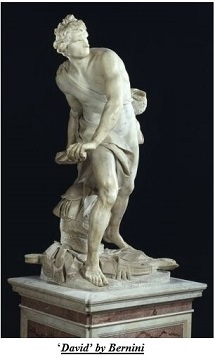
AP Art History 17th century to mod historic period
Fine art History is one of the most interesting Assignments in the Advanced Placement examination. The whole Consignment is divided into sub parts. In this commodity we'll talk about the works of fine art produced during the time period between 17thursday century and the post-modernistic era.
17th Century Baroque Art:
The extravaganza of the Baroque movement symbolises the art of the 17th century. What began at the end of the Renaissance period, flourished during the 17thursday century. The primary features of the fine art works of that period are dynamism, extreme drama and grandeur and use of brilliant colour.
The style was very much influenced past the Roman Catholic Church every bit it used the art form to express religious themes, state of war images and so on. Nosotros can witness the utilise of lite and shadow to produce intense emotions. The pop artists were Caravaggio, Rubens, Rembrandt, Bernini.
C aravaggio'due south fashion is far more different from his contemporaries. As we tin witness in The 'Bacchus' there seems to exist nix god like, rather more than human like quality of the god. Unlike Renaissance where the discipline seemed to have an eternal presence, hither the subjects were caught at the moment of activity which casts an impression of continuation which makes information technology thrilling to some extent. Besides we must not forget the dramatic use of colour which increases the grandeur of the painting very much.

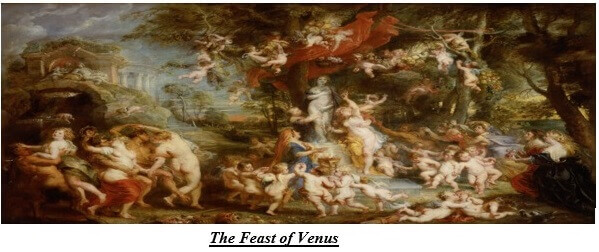
Peter Paul Rubens was a close follower of Caravaggio and intended to create a dramatic effect with minimal details. His knack for painting fleshy women with bend gave nativity to the term ' Rubenesque'. Some of his famous paintings are, ' Allegory on the Blessings of Peace', Consequences of War' and and then on.
Rembrandt was the bang-up gimmicky Dutch artist of and was a rival to Paul Rubens. Rembrandt's paintings depict the Biblical scenes, history and lots of self-portraits. His paintings were different from his contemporaries, different from landscape or still life portraits. Vividly dramatic, magnificent work of lightand shed, thick castor strokes all of these are characteristics of his paintings. Some of his famous paintings are, ' The Beefcake Lesson of Dr. Nicholaes Tulp', 'Bathsheba', 'The Night Watch' and and so on.
Autonomously from the paintings, we have sculptures fabricated by Bernini besides. He was an Italian artist. Post-obit all the Baroque artists, his sculptures besides testify vivid dynamism, the emotional intensity. His subjects too were caught in a moment of action, which makes his works more realistic. Some of his famous sculptures are, ' Apollo and Daphne', 'The Agony of St. Teresa', 'David' and so on.

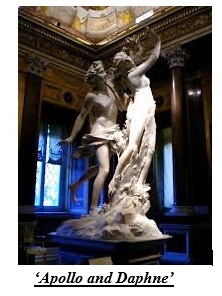
18th and 19th Century:
18th century is known for its architectural developments, achieved by artists similar Lord Burlington, William Kent and and then on. Two new styles emerged: Georgian and Regency mode. Along with this a new refreshing, cheerful style of art had been flourished, called Rococo fine art. It's a successor of Baroque period. It developed in France and by and large associated with King Louis XV. The famous artists of this way are Jean Honore Fragonard, Francois Boucher and so on.
Afterward, a new style of painting emerged, the satirical type which commented upon the social incorrect-doings. It also can be called the graphic art. The all-time examples are William Hogarth, Rowlandson and so on. If nosotros take a shut expect at this moving picture, ' Gin Lane' by Hogarth we tin follow the degraded condition of the city life.
eighteenthursday century as well saw excellence in the work of landscape painting and portraiture. In 1768, the Royal Academy of Arts had been established by Joshua Reynolds. The famous landscape painters were Thomas Gainsborough, Henry Raeburn and so on.
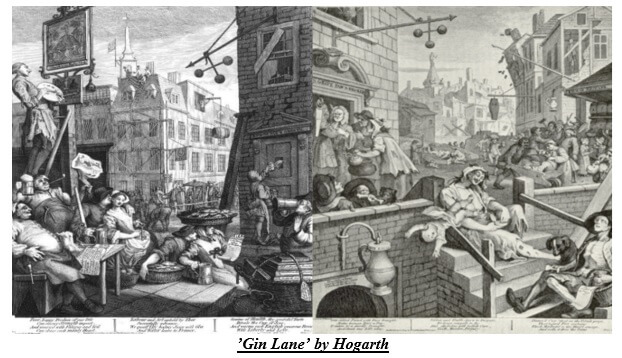

19th century witnessed the revival of Gothic fine art, revived by A.W. Pugin. It resembles people's renewed involvement in Medieval Gothic fashion of architecture.

The famous architects to follow this kind of style were Alexander Jackson Davis, Jackson Downing. This style due to its immense irregularity was by and large suited for country houses. Similar the Medieval historic period, this style was besides very much appropriate for the churches with its larger, pointy Gothic arched windows and towers. Along with this, the pitched roof, vergeboards, porches with decorated columns were also very much in use.
xxthursday Century Art:
The world of art and architecture experienced a neat change during the twentyth century. Several movements disrupted the stagnancy of the pre-existing styles and gave birth to newer forms. Among the new ones the about important ones are, Impressionism, Dadaism, Pop Fine art Move, Fauvism, High german expressionism, Abstract art, Cubism, Futurism and and then on.
Impressionism is a colourful way of painting in France at the cease of 19th century focussing on the exact analysis of the furnishings of light, color in nature. They focused on one particular time of day mostly. They used to work outdoors
and apply bright coloured strokes. They rejected the former thought that shadow of object was fabricated with brown or black colour. They pioneered the thought that the shadow tin can be fabricated with the dashes of its complementary color. The nigh famous Impressionist painters were Claude Monet, Pierre Auguste Renoir, Camille Pissaro, Winslow Homer and then on. From this mode Post-impressionism emerged. It refers to the work of few independent artists like Van Gogh, Paul Gauguin and so on.
Fauvism is a joyful, bright style of painting which includes bold colours. It was developed in France by Henri Matisse and Andre Derain. The artists were referred to every bit ' Les Fauves' pregnant the ' wild Beasts'. They used the brilliant colours to express the creative person's feeling at its highest moment.
German Expressionism is another style of art which is influenced by emotional or spiritual vision of world. This is divided into two sections:Die Brucke(The Bridge): an artistic customs of young artists in Dresden who rejected the conservative traditions of German art. The other one is Der Blaue Reiter(The Blue Rider): a grouping of artists led by Kandinsky, Macke who tried to find out the common creative ground between various Expressionist art forms.
Abstract Art consists of 2 dissimilar ways of abstraction: 'Semi', 'Pure'. The discussion ' Abstruse' refers to withdraw part of something to consider it separately. In the art grade that ' something' generally refers to the element of subject, its lines, shape, patterns etcetera. Semi Brainchild uses a blazon of stylization involving the selection, development, refinement of specific visual elements similar lines, colour to create poetic reconstruction of the subject. Pure Abstraction consists of independent visual elements as the original subject of the work.
Art works of this fourth dimension were by and large aimed to produce a sense of daze regarding the reality. This kind of works include Artist Damien Hirst's works include dot paintings, animals, dipped in formaldehyde, Jenny Savile'south disturbing nudes, Gary Hume'south abstracts and then on.

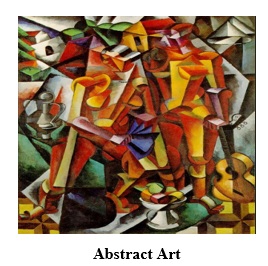
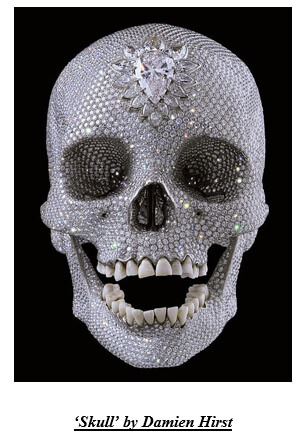
Studio Fine art
Similar the Art History Assignment, the Assignment on Studio Art is a very interesting one amid the Assignments of the Advanced Placement Exam. It's a series of inter-related Assignments like AP Fine art Cartoon, AP Studio Art 2nd and AP Studio Fine art 3D. Hither we'll discuss virtually this exciting Assignment.
Let usa talk a little bit about what is Studio Art itself.
The term ' Studio Fine art' refers to both the performing and visual art. It places its insistence upon the applicability of the knowledge gathered by the Assignment on Art History. It comprises of art works produced inside the studio of the artists or the students individually, independent of the intervention of the syllabus.
Structure:
The structure of the Studio Art Consignment is a little bit dissimilar one. This examination focuses on 3 categories: ' Quality', 'Concentration' and ' Breadth'. The requirements of each category vary from 1 person to some other due to the difference. Apart from the exam, the portfolios must accept certain deadlines. For three unlike categories the exam structure has 3 dissimilar portfolios.
Art Drawing:

Studio Fine art cartoon generally deals with the painting and drawing mainly. The main focus remains on the composition of lines, colour, shapes and size of the painting. The subject of the painting, every bit it seems, is not the main focus. Students of this Assignment need to submit v original artworks that represent their quality of existence capable an creative person. Secondly, they need to create a series that stand for their abilities to draw and paint in order to show their ability to correspond one thought in 12 different ways. Autonomously from this, a student as well requires to submit 12 slides more than to show his or her power to testify the skills in drawing, painting, use of light and shade etc.
AP Studio Fine art 2D:

Equally the name suggests, this Assignment focuses more on the ii-dimensional approach of the art like the graphic blueprint, photography, weaving or collage making. Different the Fine art Cartoon Consignment where the focus is on the way of working and the production, this Consignment focuses on the design of the work. Here the student needs to submit 5 works of art that proves the student'south ability to blueprint 2D pieces, related to 1 idea. In the second stage, the pupil requires to submit 12 slides of artwork, focusing on one idea. In the final stage, the pupil needs to submit 12 boosted slides in order to prove his or her ability to produce second designs combining the main principles, the unity, residual, dissimilarity, proportion, variety, the human relationship between the subject and the ground.
AP Studio Art 3D:
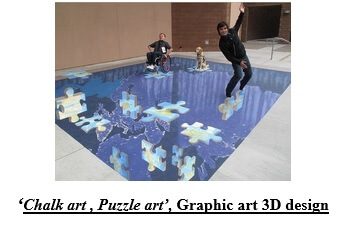
This Assignment focuses on the three-dimensional creative works such as making of models, artworks made of ceramics, metal etcetera. Here also the focus lies on the design only. As the portability is a fiddling flake problematic in these types of artworks, therefore 5 pieces of artworks can be shown in x different slides. In the 2nd step, similar the previous ones, the student needs to submit 12 dissimilar slides containing artwork focused on one single idea. Finally, he or she needs to produce 8 slides to testify the 3D skills.
This Assignment is most important as it helps the students to acquire both theoretical and practical knowledge and also gives them an opportunity to acquire while working.
Source: https://www.assignmenthelp.net/ap-art-history
0 Response to "The Placement of Different Figures Ap Art History"
Post a Comment